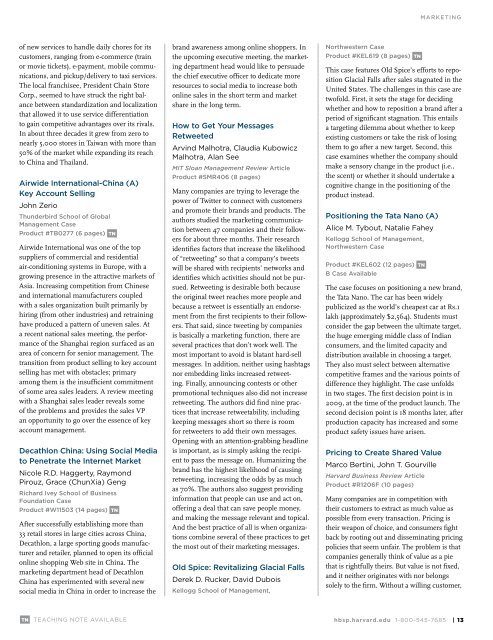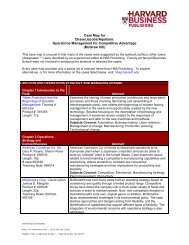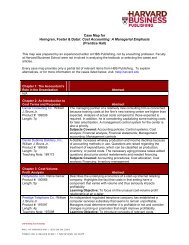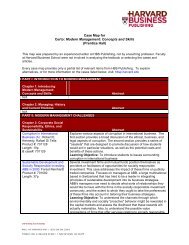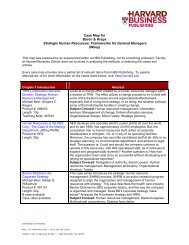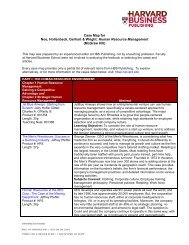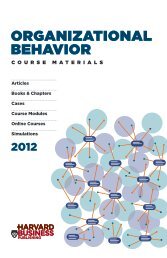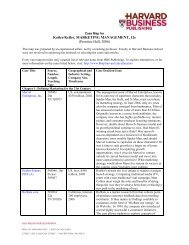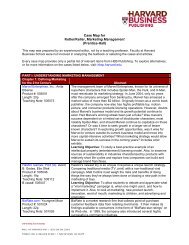teAcHing MATErIAlS - Harvard Business School Press
teAcHing MATErIAlS - Harvard Business School Press
teAcHing MATErIAlS - Harvard Business School Press
You also want an ePaper? Increase the reach of your titles
YUMPU automatically turns print PDFs into web optimized ePapers that Google loves.
of new services to handle daily chores for its<br />
customers, ranging from e-commerce (train<br />
or movie tickets), e-payment, mobile communications,<br />
and pickup/delivery to taxi services.<br />
The local franchisee, President Chain Store<br />
Corp., seemed to have struck the right balance<br />
between standardization and localization<br />
that allowed it to use service differentiation<br />
to gain competitive advantages over its rivals.<br />
In about three decades it grew from zero to<br />
nearly 5,000 stores in Taiwan with more than<br />
50% of the market while expanding its reach<br />
to China and Thailand.<br />
Airwide International-China (A)<br />
Key Account Selling<br />
John Zerio<br />
Thunderbird <strong>School</strong> of Global<br />
Management Case<br />
Product #TB0277 (6 pages) tn<br />
Airwide International was one of the top<br />
suppliers of commercial and residential<br />
air-conditioning systems in Europe, with a<br />
growing presence in the attractive markets of<br />
Asia. Increasing competition from Chinese<br />
and international manufacturers coupled<br />
with a sales organization built primarily by<br />
hiring (from other industries) and retraining<br />
have produced a pattern of uneven sales. At<br />
a recent national sales meeting, the performance<br />
of the Shanghai region surfaced as an<br />
area of concern for senior management. The<br />
transition from product selling to key account<br />
selling has met with obstacles; primary<br />
among them is the insufficient commitment<br />
of some area sales leaders. A review meeting<br />
with a Shanghai sales leader reveals some<br />
of the problems and provides the sales VP<br />
an opportunity to go over the essence of key<br />
account management.<br />
Decathlon China: Using Social Media<br />
to Penetrate the Internet Market<br />
Nicole R.D. haggerty, Raymond<br />
Pirouz, Grace (ChunXia) Geng<br />
Richard Ivey <strong>School</strong> of <strong>Business</strong><br />
Foundation Case<br />
Product #W11503 (14 pages) tn<br />
After successfully establishing more than<br />
33 retail stores in large cities across China,<br />
Decathlon, a large sporting goods manufacturer<br />
and retailer, planned to open its official<br />
online shopping Web site in China. The<br />
marketing department head of Decathlon<br />
China has experimented with several new<br />
social media in China in order to increase the<br />
tn TEAChiNG NOTE AVAiLABLE<br />
brand awareness among online shoppers. In<br />
the upcoming executive meeting, the marketing<br />
department head would like to persuade<br />
the chief executive officer to dedicate more<br />
resources to social media to increase both<br />
online sales in the short term and market<br />
share in the long term.<br />
How to Get Your Messages<br />
Retweeted<br />
Arvind Malhotra, Claudia Kubowicz<br />
Malhotra, Alan See<br />
MIT Sloan Management Review Article<br />
Product #SMR406 (8 pages)<br />
Many companies are trying to leverage the<br />
power of Twitter to connect with customers<br />
and promote their brands and products. The<br />
authors studied the marketing communication<br />
between 47 companies and their followers<br />
for about three months. Their research<br />
identifies factors that increase the likelihood<br />
of “retweeting” so that a company’s tweets<br />
will be shared with recipients’ networks and<br />
identifies which activities should not be pursued.<br />
Retweeting is desirable both because<br />
the original tweet reaches more people and<br />
because a retweet is essentially an endorsement<br />
from the first recipients to their followers.<br />
That said, since tweeting by companies<br />
is basically a marketing function, there are<br />
several practices that don’t work well. The<br />
most important to avoid is blatant hard-sell<br />
messages. In addition, neither using hashtags<br />
nor embedding links increased retweeting.<br />
Finally, announcing contests or other<br />
promotional techniques also did not increase<br />
retweeting. The authors did find nine practices<br />
that increase retweetability, including<br />
keeping messages short so there is room<br />
for retweeters to add their own messages.<br />
Opening with an attention-grabbing headline<br />
is important, as is simply asking the recipient<br />
to pass the message on. Humanizing the<br />
brand has the highest likelihood of causing<br />
retweeting, increasing the odds by as much<br />
as 70%. The authors also suggest providing<br />
information that people can use and act on,<br />
offering a deal that can save people money,<br />
and making the message relevant and topical.<br />
And the best practice of all is when organizations<br />
combine several of these practices to get<br />
the most out of their marketing messages.<br />
Old Spice: Revitalizing Glacial Falls<br />
Derek D. Rucker, David Dubois<br />
Kellogg <strong>School</strong> of Management,<br />
Northwestern Case<br />
Product #KEL619 (8 pages) tn<br />
This case features Old Spice’s efforts to reposition<br />
Glacial Falls after sales stagnated in the<br />
United States. The challenges in this case are<br />
twofold. First, it sets the stage for deciding<br />
whether and how to reposition a brand after a<br />
period of significant stagnation. This entails<br />
a targeting dilemma about whether to keep<br />
existing customers or take the risk of losing<br />
them to go after a new target. Second, this<br />
case examines whether the company should<br />
make a sensory change in the product (i.e.,<br />
the scent) or whether it should undertake a<br />
cognitive change in the positioning of the<br />
product instead.<br />
Positioning the Tata Nano (A)<br />
Alice M. Tybout, Natalie Fahey<br />
Kellogg <strong>School</strong> of Management,<br />
Northwestern Case<br />
MARKETING<br />
Product #KEL602 (12 pages) tn<br />
B Case Available<br />
The case focuses on positioning a new brand,<br />
the Tata Nano. The car has been widely<br />
publicized as the world’s cheapest car at Rs.1<br />
lakh (approximately $2,564). Students must<br />
consider the gap between the ultimate target,<br />
the huge emerging middle class of Indian<br />
consumers, and the limited capacity and<br />
distribution available in choosing a target.<br />
They also must select between alternative<br />
competitive frames and the various points of<br />
difference they highlight. The case unfolds<br />
in two stages. The first decision point is in<br />
2009, at the time of the product launch. The<br />
second decision point is 18 months later, after<br />
production capacity has increased and some<br />
product safety issues have arisen.<br />
Pricing to Create Shared Value<br />
Marco Bertini, John T. Gourville<br />
<strong>Harvard</strong> <strong>Business</strong> Review Article<br />
Product #R1206F (10 pages)<br />
Many companies are in competition with<br />
their customers to extract as much value as<br />
possible from every transaction. Pricing is<br />
their weapon of choice, and consumers fight<br />
back by rooting out and disseminating pricing<br />
policies that seem unfair. The problem is that<br />
companies generally think of value as a pie<br />
that is rightfully theirs. But value is not fixed,<br />
and it neither originates with nor belongs<br />
solely to the firm. Without a willing customer,<br />
hbsp.harvard.edu 1-800-545-7685 | 13


